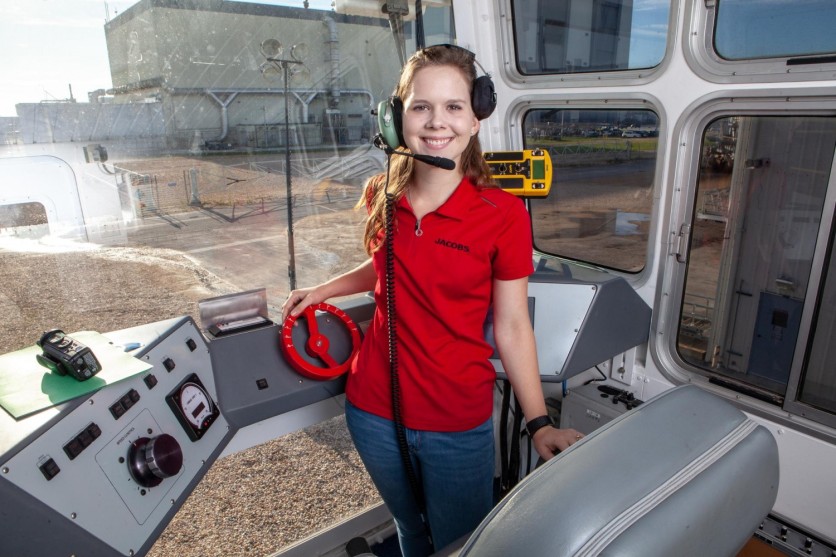On Mar. 12, NASA's Artemis-I will reach toward the expanse in the hopes of broadening human exploration to both the Moon and Mars. It will be the first of many spacebound missions under the Artemis program, which vies to put a female on the moon by 2025.
Before it can fly, however, Artemis-I must first crawl. It will do this with the help of seasoned NASA machinery, a 2,721 metric ton mammoth of a vehicle titled the Crawler Transporter 2 (CT-2).
Designed by the Bucyrus Erie Company and developed by the Marion Power Shovel Company, NASA's $14 million Crawler Transporters are the largest self-powered land vehicles in the world, weighing the equivalent of 20 fully-loaded commercial airplanes with a max carrying capacity of a little under 23 empty dump trucks. Aptly named, the Crawler Transporter hits a top speed of only 1.5 kph, but it's for a good reason as hauling a skyscraper on its back at any faster degrees would certainly be cause for imminent destruction.


The CT-2 itself will boast a forthcoming trip that will see it towing nearly 15 million pounds of the Space Launch System (SLS) and its accompanying Orion spaceship, the most powerful and largest rocket ever built. Like Uber's sophisticated and much grander form, it will taxi the SLS and Orion via its Mobile Launcher from the Vehicle Assembly Building (VAB) to the LaunchPad (39B) in preparation for Artemis-I's inevitable leap into the solar system.
Aside from sounding like the title of a 1990s action movie, NASA's Crawler has a lengthy 57 year-long history of towing some of the organization's most recognizable spacecraft, including 1969's Apollo 11, which took Neil Armstrong, Buzz Aldrin, and Michael Collins to the moon.
Its rich historiography mirrors its technological might, utilizing dual-corner eight-set tracks that feature 57 shoes on each track, every one of which weighs 2,000 lbs. Four 1,000 kW DC generators alongside two 2,050 kW V16 diesel engines power the mighty Crawler in its slow yet purposeful negotiations throughout the Kennedy Space Center.
Yet, it isn't just the machine itself that is ever highlighted here in terms of broadening our spacebound realities. Without the Crawler's dedicated pilots behind the wheel, spacecraft transportation, and the various missions that necessitate it wouldn't be possible.
Meet Sam Dove and Breanne Stichler. These two individuals are literally what drives NASA into the stairways, at least down here on Earth. Dove, a West Virginian farm boy turned US Air Force Weapons Specialist, took up Design Engineering for his first decade at the Kennedy Space Center back in 1987. After this long stint, he fell into operations, wherein engineering on the Crawler took form. He now sits in the cockpit as the senior Crawler operator, having been a part of almost 135 various shuttle missions.
"It dominates whatever's around it. You can feel the massive machine as it comes by, it shakes the ground a little bit...it would just amaze you; the size and the complexity of the world's biggest tracked-vehicle," Dove explains. "It's fun to get up every day and come out and work on the Crawler."
Stichler, on the other hand, is NASA's youngest Crawler operator and among the first females to drive the CT-2. This was her very first gig right out of college, following an internship at the space center while still in school. For Stichler, though, her commitment to NASA and the Crawler goes far beyond age and gender. It's all about the learning process, growing closer with the machine, and facilitating our adventures into the beyond.
"Every day is different on the Crawler, and there's a lot of parts and pieces to learn and become proficient in," she explains. "Being a certified Crawler driver is not just learning how to drive the machine. You must also understand and be able to operate the Crawler's other major subsystems."
While Kennedy may have nine total Crawler drivers, one of which is awaiting certification amid the lengthy two-year-long training process, the buck doesn't simply stop with just them. As Dove coins, several other key individuals, "a specialized team," help maintain full control over the operation while en route.

Stichler says, "The team is about thirty engineers and technicians that huddle up a few hours before a roll to the launch pad to review the operation, talk safety, and discuss who's in charge of each task. We switch positions throughout the roll to keep fresh eyes on the systems, we all work together to execute a successful rollout."
These are the very individuals that allow us the capacity of spacefaring. Without them, our adventures into the stars wouldn't be possible. Yes, the monster CT-2 certainly is a beast of a machine, despite being but a mere platform on wheels. Combined, however, drivers and the monster provide for a new realm of spaceflight, urging us ever closer to Mars - and possibly even well beyond.
"The Crawler moved the Apollo/Saturn rockets and Space Shuttles to the pad, so NASA's dedication goes back many generations," says Dove. "Now we will be moving SLS/Orion to the launch pad. We're all part of a team that believes in what we do. It will take all of our efforts, experience, knowledge, and energy, as a team, to accomplish our return to the Moon successfully. I fully expect that Breanne [Stichler] and the other younger engineers will learn, excel, and make meaningful contributions to this program as we return to the deep space exploration. We all stand on the shoulders of giants before us."
ⓒ 2026 TECHTIMES.com All rights reserved. Do not reproduce without permission.




